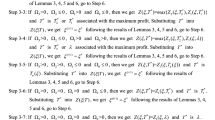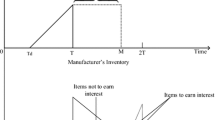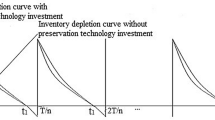Abstract
Whenever a supplier proclaims a price rise, the effect is amplified at a predetermined point in the future. At that point, each retailer should decide whether to buy more stock or to purchase at a higher price to take benefit of the present lower price. The result of price changes on the retailer's daily replenishment strategy for deteriorating items with expiry dates is discussed in this model. Price-sensitive demand is addressed in this research and is appropriate for products whose demand falls rapidly as the price of the product rises. This article advocates two scenarios: (I) when the special-order time coincides with the retailer’s replenishment time; and (II) when the special-order time occurs during the retailer’s sales period. The crucial objective of this article is to determine the best ordering policies for the retailer in all cases that reduce the profit difference function between the regular order and the special order during the reduction time of the special-order quantity concerning cycle time, selling price, and investment for preservation technology. The scenarios are set up and demonstrated with numerical illustrations. Additionally, to investigate the impacts of key parameters on an optimum solution, a sensitivity analysis is carried out.
Access this chapter
Tax calculation will be finalised at checkout
Purchases are for personal use only
Similar content being viewed by others
References
Naddor E (1966) Inventory systems. Wiley, New York, NY
Lev B, Soyster AL (1979) An inventory model with finite horizon and price changes. J Oper Res Soc 30(1):43–53
Goyal SK (1979) A note on the paper: an inventory model with the finite horizon and price changes. J Oper Res Soc 30(9):839–842
Lev B, Weiss HJ (1990) Inventory models with cost changes. Oper Res 38(1):53–63
Goyal SK, Srinivasan GF, Arcelus F (1991) One-time only incentives and inventory policies. Eur J Oper Res 54(1):1–6
Khouja M, Park S (2003) Optimal lot sizing under continuous price decrease. Omega 31(6):539–545
Ouyang LY, Wu KS, Yang CT, Yen HF (2014) Optimal order policy in response to the announced price increase for deteriorating items with limited special-order quantity. Int J Syst Sci 47(3):718–729
Harris FW (1913) How many parts to make at once. Fact Mag Manag 10(2):135–136, 152
Hariga M (1996) Optimal EOQ models for deteriorating items with time-varying demand. J Oper Res Soc 47(10):1228–1246
Panda S, Senapati S, Basu M (2008) Optimal replenishment policy for perishable seasonal products in a season with ramp-type time-dependent demand. Comput Ind Eng 54(2):301–314
Hossen MA, Hakim MdA, Ahmed SS, Uddin MS (2016) An inventory model with price and time-dependent demand with fuzzy valued inventory costs under inflation. Ann Pure Appl Math 11(2):21–32
Shah NH, Jani MY, Chaudhari B (2017) Retailer’s optimal policies for price-credit dependent trapezoidal demand under two-level trade credit. Int J Oper Quant Manag 23(02):115–130
Mashud A, Khan M, Uddin M, Islam M (2018) A non-instantaneous inventory model having different deterioration rates with stock and price dependent demand under partially backlogged shortages. Uncertain Supply Chain Manag 6(1):49–64
Agi MAN, Soni HN (2020) Joint pricing and inventory decisions for perishable products with age-, stock-, and price-dependent demand rate. J Oper Res Soc 71(1):85–99
Ghare PM, Schrader GH (1963) A model for the exponentially decaying inventory system. J Ind Eng 14(5):238–243
Philip GC (1974) A generalized EOQ model for items with weibull distribution deterioration. AIIE Trans 6(2):159–162
Yang HL (2004) Two-warehouse inventory models for deteriorating items with shortages under inflation. Eur J Oper Res 157(2):344–356
Skouri K, Konstantaras I, Papachristos S, Ganas I (2009) Inventory models with ramp type demand rate, partial backlogging, and Weibull deterioration rate. Eur J Oper Res 192(1):79–92
Tripathi RP, Tomar SS (2015) Optimal order policy for deteriorating items with time-dependent demand in response to temporary price discounts linked to order quantity. Int J Math Anal 23(9):1095–1109
Shah NH, Jani MY, Chaudhari UB (2016) Impact of future price increase on ordering policies for deteriorating items under quadratic demand. Int J Ind Eng Comput 7(3):423–436
Jani MY, Shah NH, Chaudhari UB (2020) Inventory control policies for time-dependent deteriorating item with variable demand and two-level order linked trade credit. Optim Inven Manag 55–67
Hwang H, Kim D, Kim Y (1993) Multiproduct economic lot size models with investment costs for setup reduction and quality improvement. Int J Prod Res 31(3):691–703
Hsu PH, Wee HM, Teng HM (2010) Preservation technology investment for deteriorating inventory’. Int J Prod Econ 124(1):388–394
Dye CY, Hsieh TP (2012) An optimal replenishment policy for deteriorating items with effective investment in preservation technology. Eur J Oper Res 218(1):106–112
Shah NH, Chaudhari UB, Jani MY (2017) Optimal policies for a time-varying deteriorating item with preservation technology under selling price and trade credit-dependent quadratic demand in a supply chain. Int J Appl Comput Math 3(2):363–379
Chaudhari UB, Shah N\H, Jani MY (2020) Inventory modelling of deteriorating item and preservation technology with advance payment scheme under quadratic demand. Optim Inven Manag 69–79
Cárdenas-Barrón LE, Sana SS (2015) Multi-item EOQ inventory model in a two-layer supply chain while demand varies with a promotional effort. Appl Math Model 39(21):6725–6737
Author information
Authors and Affiliations
Editor information
Editors and Affiliations
Rights and permissions
Copyright information
© 2022 The Author(s), under exclusive license to Springer Nature Singapore Pte Ltd.
About this paper
Cite this paper
Jani, M.Y., Betheja, M.R., Chaudhari, U. (2022). Impact of Forthcoming Price Increase for Maximum Fixed Lifetime Product with Preservation Technology Investment and Price-Sensitive Demand. In: Singh, M.K., Gautam, R.K. (eds) Recent Trends in Design, Materials and Manufacturing. Lecture Notes in Mechanical Engineering. Springer, Singapore. https://doi.org/10.1007/978-981-16-4083-4_7
Download citation
DOI: https://doi.org/10.1007/978-981-16-4083-4_7
Published:
Publisher Name: Springer, Singapore
Print ISBN: 978-981-16-4082-7
Online ISBN: 978-981-16-4083-4
eBook Packages: EngineeringEngineering (R0)




